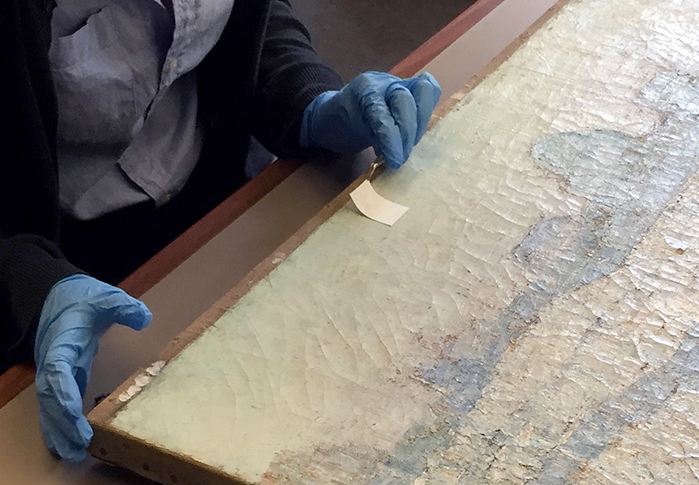The Use of Nonwoven Microfiber Poultices in Paintings Conservation
An Introduction to Ongoing Research
[von: Kari Rayner, Andrew W. Mellon Fellow in Paintings Conservation at the National Gallery of Art, Washington, D.C.]
Although Evolon® CR was originally distributed by Deffner & Johann as a cleaning and packing nonwoven, it has gained traction as an effective poulticing substrate for the treatment of paper and paintings in recent years and has been the focus of a number of student projects at various universities in Europe and the United States. Evolon® CR’s capacity to adsorb strongly through capillary action, dual polar/non-polar character, flexibility, and resistance to solvents recommend the material for this purpose. Since its nonwoven structure does not snag or leave fibers, and poulticing decreases the mechanical action necessary to remove varnish or overpaint from a paint surface, it can be particularly useful in lieu of swab cleaning for works that have underbound or cupped paint.
The attached poster, which I originally developed for the 2017 Annual Meeting of the American Institute for Conservation of Historic and Artistic Works, focuses primarily on the treatment of The Duke of York, a painting attributed to John Riley in the collection of the Honourable Society of the Middle Temple, London. Carried out at the Hamilton Kerr Institute, the treatment of this seventeenth-century work - measuring 234 x 148 centimeters (92 x 58 inches) - involved developing a method to use Evolon® CR to poultice varnish on a large scale. The use of this material was prompted by (1) the extreme thickness and polarity of the natural resin coatings(s) and overpaint that were present, and (2) the abraded and underbound condition of the original paint. The poster contains additional details of the treatment rationale and application method.
As an Andrew W. Mellon Fellow in Paintings Conservation at the National Gallery of Art, Washington, D.C., I’ve been investigating the potential of various other types of microfibers provided by Deffner & Johann. I am additionally testing the suitability of Evolon® CR and other nonwoven microfibers for removing synthetic varnishes. This has involved experimentation with microfiber poultices and various organic solvents on naturally-aged twenty-year-old synthetic varnish samples on glass from the National Gallery of Art’s Scientific Research Department.
I’ve also found microfiber poultices to be useful in the treatment of several paintings from the National Gallery of Art’s collection. For instance, in treating Boathouse, Winter, Harlem River by Ernest Lawson, I encountered some difficulties fully solubilizing the poly(iso-butyl methacrylate) coating and removing it: use of a cotton swab seemed to push the varnish around on the surface rather than picking it up. Additionally, cotton fibers tended to catch on the thickly textured paint and become stuck in the partially solubilized varnish; therefore, I’ve been experimenting with using a microfiber poultice to remove the varnish more fully without leaving fibers.

Experimenting with removing a synthetic varnish from Boathouse, Winter, Harlem River with a nonwoven microfiber poultice
Photo credit: Kathryn Harada
The promising results I’ve been obtaining from these tests and case studies support other studies concluding that using nonwoven microfibers can be advantageous in a variety of circumstances, and the results of this research at the National Gallery of Art may further establish a place for this type of material in a painting conservator’s toolkit.
→ high-resolution PDF of Kari Rayners Poster
(Review Photo: Placing Evolon® CR on the surface of The Duke of York
Photo credit: Sarah Bayliss)

